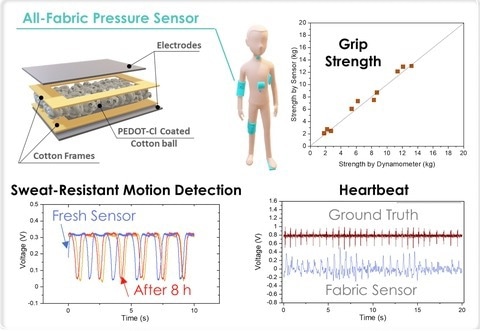
By placing the sensor on different parts of the body, a host of important physiological data can be extracted. Image Credit: Homayounfar et al.
One way to obtain this data is with minute electromechanical sensors that convert an individual’s body’s movements—such as the indistinct pulse felt when placing a hand on the chest—into electrical signals. But what happens when a person is hugged or takes a nap lying on their stomach?
“That increased pressure overwhelms the sensor, interrupting the flow of data, and so the sensor becomes useless for monitoring natural phenomena,” Andrew continues.
To solve this issue, the researchers created a sensor that keeps functioning even when hugged, leaned on, sat upon, or otherwise squeezed by everyday interactions. The secret lies in vapor-printing clothing fabrics with piezoionic materials like PEDOT-Cl (p-doped poly(3,4-ethylenedioxythiophene-chloride).
Details of this study were illustrated in the journal Advanced Materials Technologies.
With this technique, even the slightest body movement, such as a heartbeat, results in the redistribution of ions all over the sensor. Simply put, the fabric converts the mechanical motion of the body into an electrical signal, which can then be tracked.
This is the first fabric-based sensor allowing for real-time monitoring of sensitive target populations, from workers laboring in stressful industrial settings to kids and rehabilitation patients.
Zohreh Homayounfar, Study Lead Author and Graduate Student, University of Massachusetts Amherst
One of the key advantages is that this all-fabric sensor can be worn in snug loose-fitting clothing rather than be implanted in tight-fitting fabrics or added straight onto the skin. This makes it much simpler for the sensors to collect long-term data, such as respiration, heartbeats, vocalization, step counts, joint movement, and grip strength—a vital health indicator that can help clinicians monitor everything spanning from bone density to depression.
Journal Reference:
Homayounfar, S. Z., et al. (2023) Humidity-Resistant, Broad-Range Pressure Sensors for Garment-Integrated Health, Motion, and Grip Strength Monitoring in Natural Environments. Advanced Materials Technologies. doi.org/ 10.1002/admt.202201313.